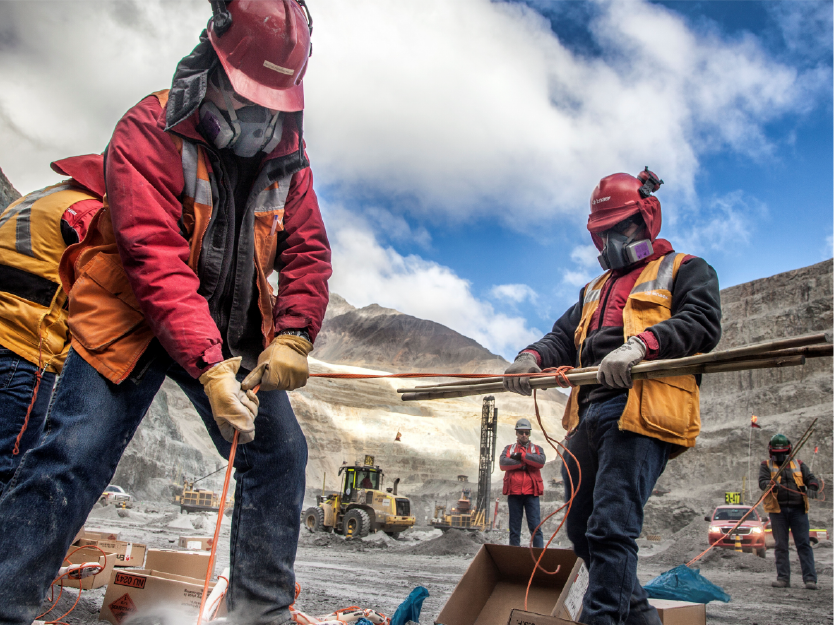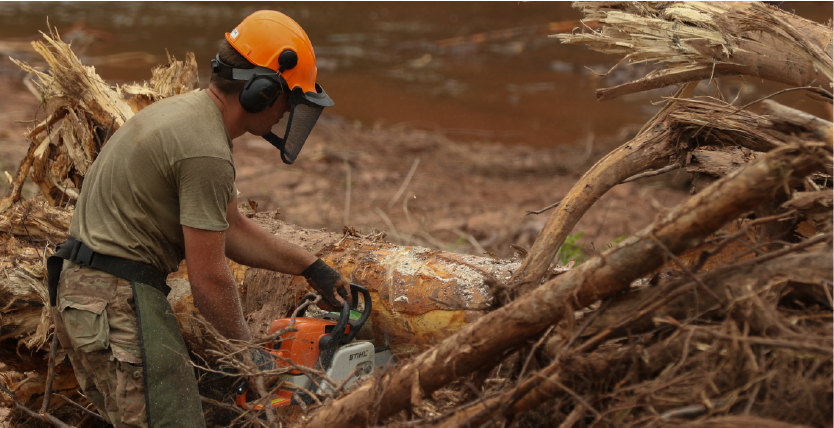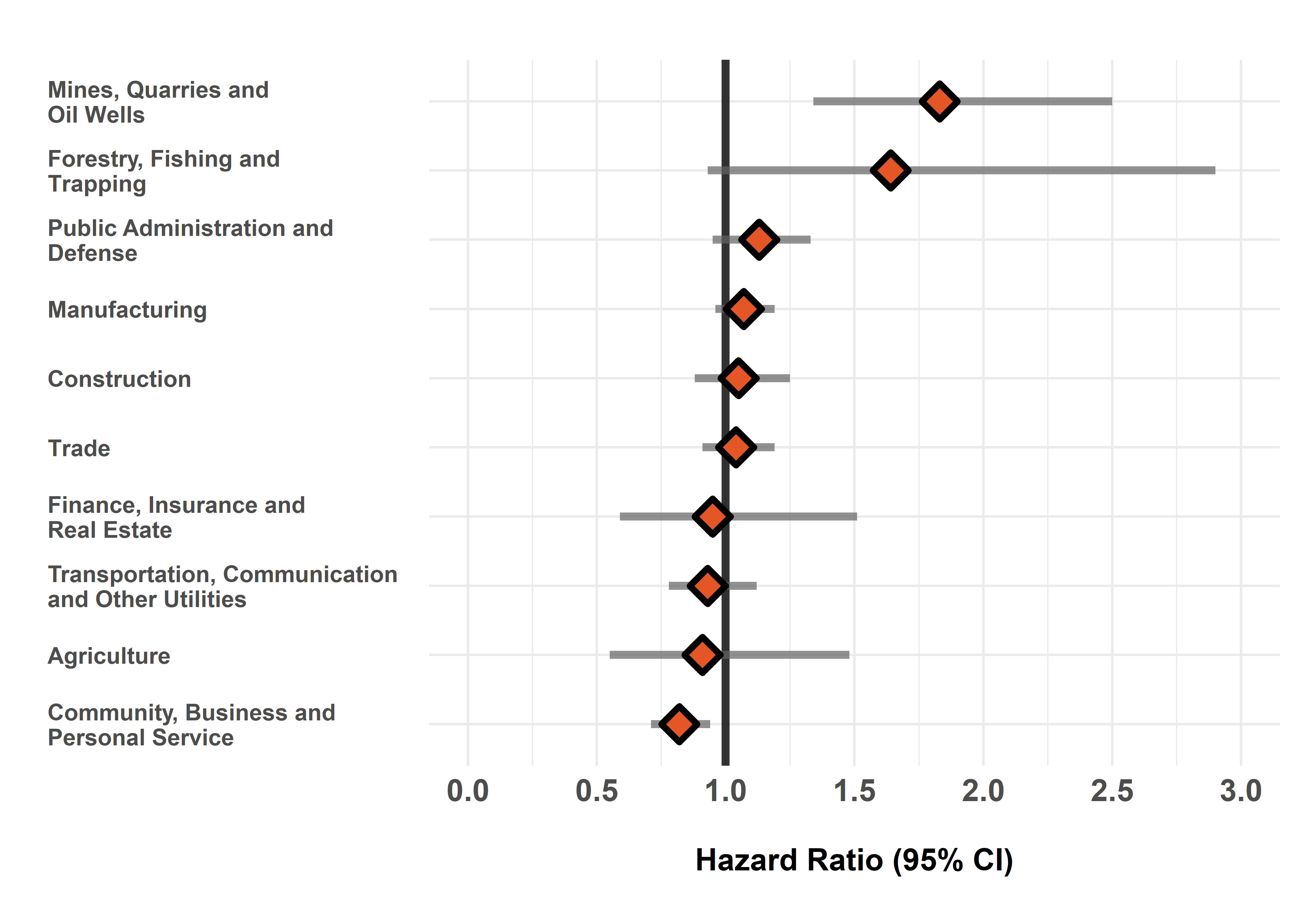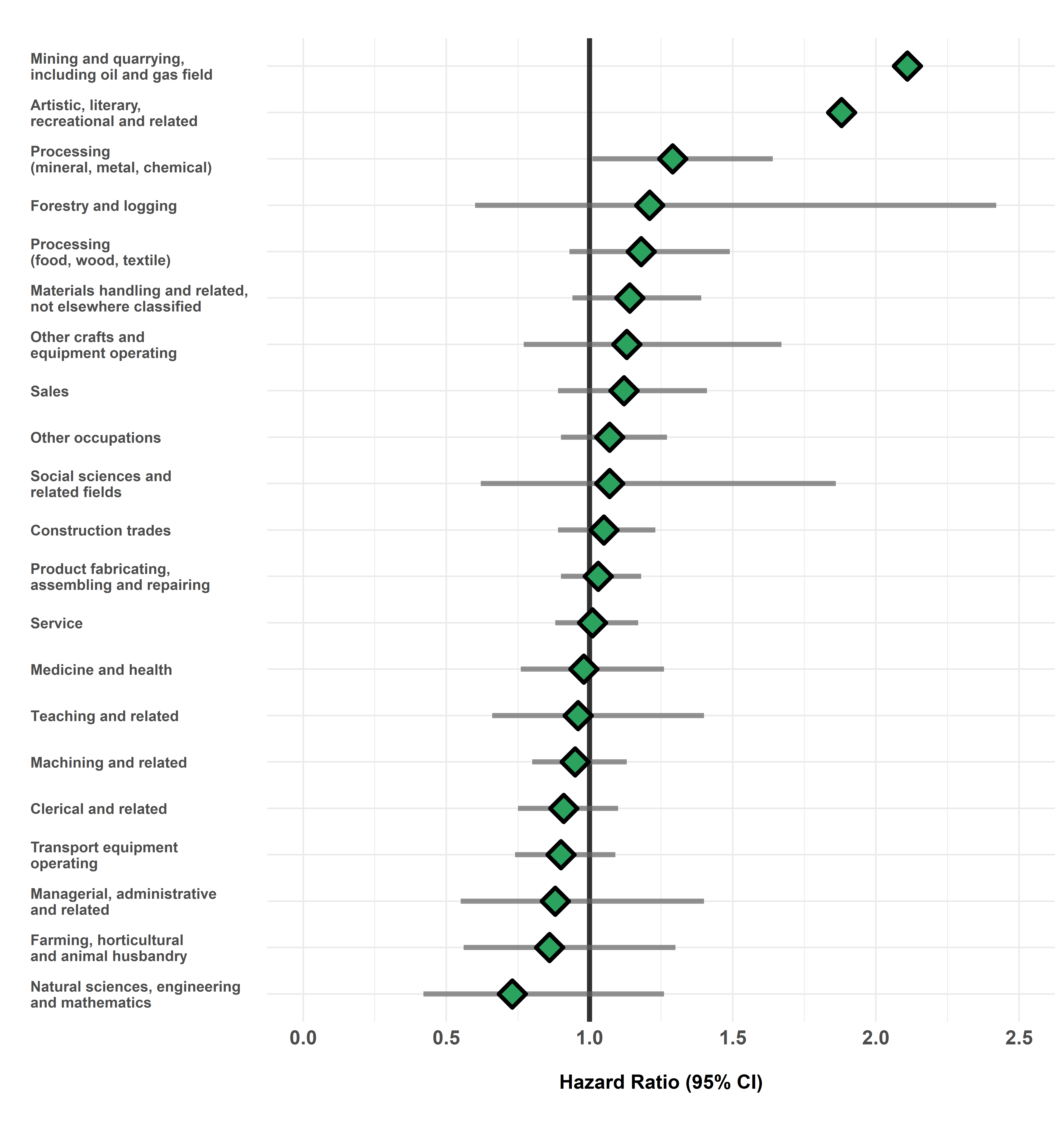Idiopathic Pulmonary Fibrosis (IPF)
Background
Idiopathic Pulmonary Fibrosis (IPF) is a respiratory disease involving scarring of the lungs resulting in reduced lung capacity. The term idiopathic is used to describe conditions of an unknown cause, but family history and smoking are both thought to be risk factors for IPF. This disease is the most common fibrotic lung disease and is similar to silicosis and asbestosis. IPF has poor five-year survival and treatment options are limited.
Possible occupational risk factors
-
- Metal dust
- Wood dust
- Animal dust from livestock farming
Because there is not yet a comprehensive understanding of the causes of IPF, the ODSS project sought to understand what occupations and industries were at an increased risk of this disease as an important step toward prevention. Metal and wood dusts are important possible occupational risk factors for IPF.
Key Findings
The greatest risks of IPF were observed among workers employed in the mining, forestry and papermaking, and food and beverage sectors.
Mining
 The mining industry overall is at 2 times the risk of IPF. Groups within this industry with elevated risks include the gold quartz and uranium mining sectors, as well as drilling and blasting occupations and cutting and loading occupations. These occupations and industries would likely have significant dust exposure, including metals, silica, and diesel engine exhaust.
The mining industry overall is at 2 times the risk of IPF. Groups within this industry with elevated risks include the gold quartz and uranium mining sectors, as well as drilling and blasting occupations and cutting and loading occupations. These occupations and industries would likely have significant dust exposure, including metals, silica, and diesel engine exhaust.
-
- Gold quartz mines: 3.6 times the risk
- Uranium mines: 3.2 times the risk
- Rock and soil drilling occupations: 2 times the risk
Forestry
 Workers within the logging and pulp and papermaking industries are at increased risks of IPF. These workers are likely exposed to high levels of wood dust, which is a possible risk factor for IPF.
Workers within the logging and pulp and papermaking industries are at increased risks of IPF. These workers are likely exposed to high levels of wood dust, which is a possible risk factor for IPF.
-
- Logging: 1.5 times the risk
- Occupations in elemental work, pulp and papermaking: 3.8 times the risk
Food and beverage
 Cooks and chefs were at an increased risk of IPF and could be exposed to organic dusts and cooking fumes. Organic dusts such as flour and confectionary materials are known risk factors for other respiratory conditions, but it is not known whether they pose a risk for IPF.
Cooks and chefs were at an increased risk of IPF and could be exposed to organic dusts and cooking fumes. Organic dusts such as flour and confectionary materials are known risk factors for other respiratory conditions, but it is not known whether they pose a risk for IPF.
-
- Chefs and cooks: 1.5 times the risk
Relative Risk by Industry and Occupation
Figure 1. Risk of idiopathic pulmonary fibrosis diagnosis among workers employed in each industry group relative to all others, Occupational Disease Surveillance System (ODSS), 2006-2016

The hazard ratio is an estimate of the average time to diagnosis among workers in each industry/occupation group divided by that in all others during the study period. Hazard ratios above 1.00 indicate a greater risk of disease in a given group compared to all others. Estimates are adjusted for birth year and sex. The width of the 95% Confidence Interval (CI) is based on the number of cases in each group (more cases narrows the interval).
Figure 2. Risk of idiopathic pulmonary fibrosis diagnosis among workers employed in each occupation group relative to all others, Occupational Disease Surveillance System (ODSS), 2006-2016

The hazard ratio is an estimate of the average time to diagnosis among workers in each industry/occupation group divided by that in all others during the study period. Hazard ratios above 1.00 indicate a greater risk of disease in a given group compared to all others. Estimates are adjusted for birth year and sex. The width of the 95% Confidence Interval (CI) is based on the number of cases in each group (more cases narrows the interval).
Table of Results
Table 1. Surveillance of Idiopathic Pulmonary Fibrosis: Number of cases, workers employed, and hazard ratios in each industry (SIC)
| SIC Code * | Industry Group | Number of cases | Number of workers employed | Hazard Ratio (95% CI) † |
| 1 | Agriculture | 16 | 27,045 | 0.91 (0.55, 1.48) |
| 2/3 | Forestry, Fishing and Trapping |
12 | 7,409 | 1.64 (0.93, 2.90) |
| 4 | Mines, Quarries and Oil Wells |
41 | 16,975 | 1.83 (1.34, 2.50) |
| 5 | Manufacturing | 556 | 544,756 | 1.07 (0.96, 1.19) |
| 6 | Construction | 150 | 169,579 | 1.05 (0.88, 1.25) |
| 7 | Transportation, Communication and Other Utilities |
130 | 159,895 | 0.93 (0.78, 1.12) |
| 8 | Trade | 246 | 347,992 | 1.04 (0.91, 1.19) |
| 9 | Finance, Insurance and Real Estate |
18 | 18,604 | 0.95 (0.59, 1.51) |
| 10 | Community, Business and Personal Service |
290 | 471,113 | 0.82 (0.71, 0.94) |
| 11 | Public Administration and Defense |
160 | 152,359 | 1.13 (0.95, 1.33) |
| * SIC: Standard Industrial Classification (1970) | ||||
| † Hazard rate in each group relative to all others | ||||
Table 2. Surveillance of Idiopathic Pulmonary Fibrosis: Number of cases, workers employed, and hazard ratios in each occupation (CCDO) group
| CCDO Code * | Occupation Group | Number of cases | Number of workers employed | Hazard Ratio (95% CI) † |
| 11 | Managerial, administrative and related |
18 | 26,201 | 0.88 (0.55, 1.40) |
| 21 | Natural sciences, engineering and mathematics |
13 | 22,211 | 0.73 (0.42, 1.26) |
| 23 | Social sciences and related fields |
13 | 24,536 | 1.07 (0.62, 1.86) |
| 25 | Religion | 0 | 112 | — |
| 27 | Teaching and related | 29 | 41,002 | 0.96 (0.66, 1.40) |
| 31 | Medicine and health | 72 | 106,553 | 0.98 (0.76, 1.26) |
| 33 | Artistic, literary, recreational and related |
12 | 12,453 | 1.88 (1.06, 3.32) |
| 41 | Clerical and related | 110 | 157,487 | 0.91 (0.75, 1.10) |
| 51 | Sales | 80 | 120,688 | 1.12 (0.89, 1.41) |
| 61 | Service | 235 | 289,125 | 1.01 (0.88, 1.17) |
| 71 | Farming, horticultural and animal husbandry |
22 | 39,795 | 0.86 (0.56, 1.30) |
| 73 | Fishing, hunting, trapping and related |
<5 | 448 | — |
| 75 | Forestry and logging | 8 | 7,301 | 1.21 (0.60, 2.42) |
| 77 | Mining and quarrying, including oil and gas field |
25 | 9,408 | 2.11 (1.42, 3.14) |
| 81 | Processing (mineral, metal, chemical) |
68 | 64,951 | 1.29 (1.01, 1.64) |
| 82 | Processing (food, wood, textile) |
73 | 79,031 | 1.18 (0.93, 1.49) |
| 83 | Machining and related | 143 | 156,151 | 0.95 (0.80, 1.13) |
| 85 | Product fabricating, assembling and repairing |
266 | 267,522 | 1.03 (0.90, 1.18) |
| 87 | Construction trades | 175 | 174,623 | 1.05 (0.89, 1.23) |
| 91 | Transport equipment operating |
113 | 138,165 | 0.90 (0.74, 1.09) |
| 93 | Materials handling and related, not elsewhere classified |
111 | 123,954 | 1.14 (0.94, 1.39) |
| 95 | Other crafts and equipment operating |
26 | 22,446 | 1.13 (0.77, 1.67) |
| 99 | Other occupations not elsewhere classified | 145 | 174,331 | 1.07 (0.90, 1.27) |
| * CCDO: Canadian Classification Dictionary of Occupations (1971) | ||||
| † Hazard rate in each group relative to all others | ||||
Please note that ODSS results shown here may differ from those previously published or presented. This may occur due to changes in case definitions, methodological approaches, and the ongoing nature of the surveillance cohort.
